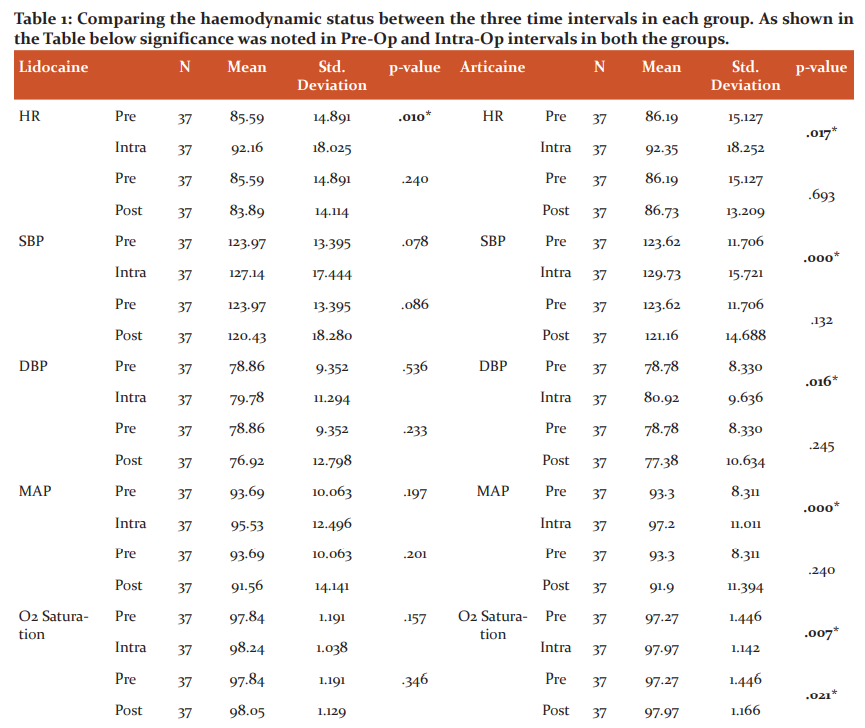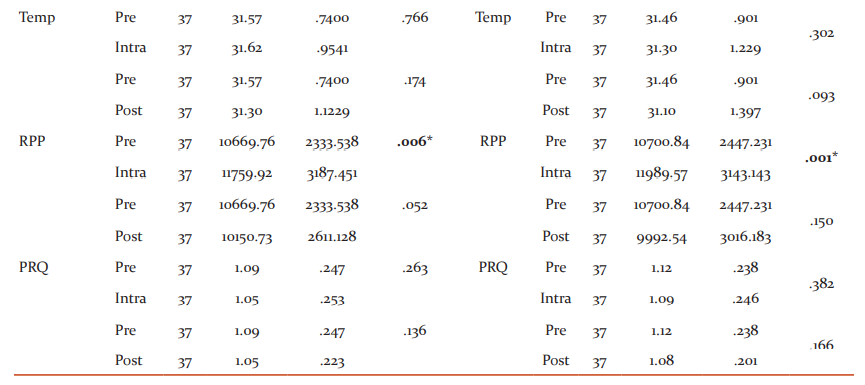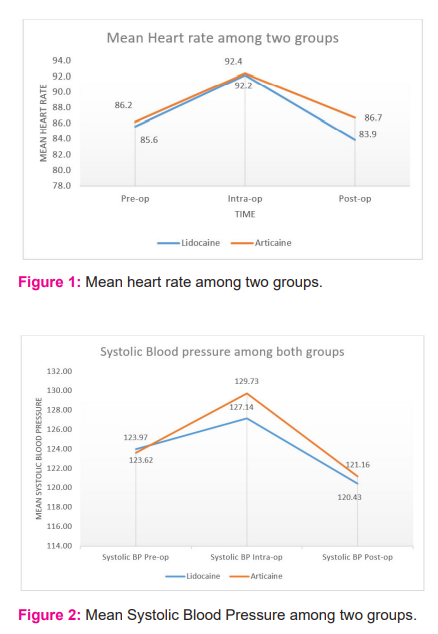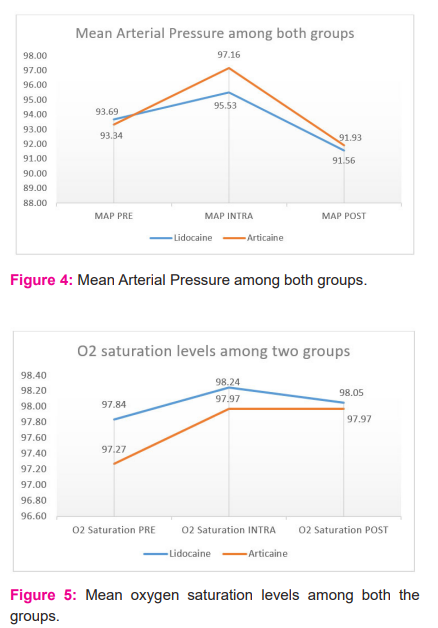IJCRR - 14(2), January, 2022
Pages: 68-73
Date of Publication: 16-Jan-2022
Print Article
Download XML Download PDF
Comparative Evaluation of Haemodynamic Changes in Patients Undergoing Surgical Removal of Bilateral Impacted Lower Third Molars using 2% Lidocaine vs 4% Articaine with 1:100000 Epinephrine Concentration: A Double-Blind Randomised Study
Author: Shenoy K Vandana, Dutta Ron, G Gayathri, Mohamed Afradh, Kumar K Senthil
Category: Healthcare
Abstract:Introduction: Impacted mandibular third molars are one of the most common findings in the field of dentistry which requires surgical removal. Local Anaesthetics plays a major role to perform the procedure pain-free although the anesthetics may exhibit some haemodynamic changes. Aim: This study aimed to assess and compare the hemodynamic changes during the surgical removal of lower bilateral impacted third molars using local anaesthetic agents 2% Lidocaine or 4%Articaine both in conjunction with 1:100000 epinephrine concentration. Methodology: Forty-one patients with a mean age of 32.6 were enrolled to bilateral surgical removal of lower impacted third molars with an interval of three to four weeks between each surgery. Clinical parameters like Heart Rate, Systolic Blood Pressure, Diastolic Blood Pressure, Mean Arterial Pressure, Peripheral Saturation of Oxygen, Temperature and calculated parameters like Rate Pressure Product and Pressure Rate Quotient were assessed at three different time points: baselilne (Pre-operatively), Osteotomy/Odontosection/Luxation (Intra-operatively) and five minutes after completion of suture (Post-operatively). Result: Forty-one patients underwent thorough clinical examination, among which 33 patients fulfilled the criteria as they participated in both the surgical procedures. The present study found significant difference in the haemodynamic changes when comparing between the three-time intervals in each group during the surgical procedure Conclusion: No significant differences were found when comparing the hemodynamic behavior between both the groups (2% lidocaine and 4% articaine) although significant differences were noted when comparing between the time points within each group.
Keywords: Lidocaine, Articaine, Epinephrine, Anaesthetic, Haemodynamic
Full Text:
INTRODUCTION
The surgical removal of third molars is the most common and routine procedure in the field of Oral and Maxillofacial Surgery. Local anesthetic plays a major role in limiting pain and providing a pain-free procedure. Most of the local anesthetics are generally used in conjunction with a vasoconstrictor to delay the absorption of the local anesthetic prolonging the duration of the anesthetic and also providing a bloodless field. In the literature by Neves et al.1,2007and Elad et al.2,2008 have confirmed the safety of using a local anaesthetic with a vasoconstrictor. Other few kinds of literature by Vasconcellos et al.3,2008 and Sancho-Puchades et al.4,2012 have reported that patients who undergo surgical removal of third molars showed significant variations in blood pressure and heart rate.
Articaine is an amide local anesthetic that contains a ‘thiophene’ ring instead of an aromatic ring thereby increasing liposolubility and potency.
The aim of the study is to assess and compare the hemodynamic effects on patients undergoing surgical removal of lower third molar using 2 % lidocaine hydrochloride with 1:100000 concentration of epinephrine and 4 % articaine hydrochloride with 1:100000 concentration of epinephrine.
MATERIALS AND METHOD
Study design: This retrospective, randomised, controlled double-blinded split-mouth study is approved by the Ethical Committee of the author’s University. All of the participants enrolled in the study read and signed an informed consent confirming their acceptance to take part in the study. The study composed of two groups: Group A (procedure done under 2% Lidocaine with 1:100000 Epinephrine) and Group B (procedure done under 4% Articaine with 1:100000 Epinephrine)
Sample Design 41 healthy individuals aged between 18-40 years from September 2019 to March 2020 undergoing surgical removal of bilateral lower third molar impaction with a time interval of 3-4 weeks between the two surgical extractions were included in this study based on clinical examinations and radiographs. Impactions grading moderately difficult according to Pederson Scale was included in the study. The following exclusion criteria were applied: Patients with general health issues like hypertension, diabetes and cardiac disorders, patients with hypersensitivity to the drugs used in research, pregnant or lactating women, patients on blood thinners and mentally challenged patients.
Blinding Details Both surgeon and patient were blinded on what anaesthetic solution is been used. Blinding technique was done by covering the cartridge with two colored tapes to separate the two study groups. Only the assistant had access to the colour codes. On initial examination, the patient was directed to select from two sealed envelopes referring to the site of surgical removal (i.e. impacted 38 or impacted 48) along with the color-coded cartridge containing the anaesthetic agent (i.e. either 2% Lidocaine or 4% Articaine) both of which used in conjunction with 1:100000 Epinephrine concentration. As soon as the assistant opened the envelope, the surgeon was informed about the site of surgery and the colour-coded anaesthetic cartridge was given. The second surgery was carried out on the contralateral side with the other type of anaesthetic agent after 3-4 weeks.
Study Variables Clinical parameters like Heart Rate (HR), Systolic Blood Pressure (SBP), Diastolic Blood Pressure (DBP), Peripheral O2 Saturation (SpO2) and Temperature (Temp.)(?C) and calculated parameters as Mean Arterial Pressure (MAP), Rate Pressure Product (RPP) and Pressure Rate Quotient (PRQ) at three different time points during the surgical procedure:(1) Baseline at rest (Preoperative), (2) incision, flap elevation, osteotomy after administration of local anaesthetics (Intraoperative) and (3) five minutes after completion of suture (Postoperative). All of the clinical parameters were recorded using a Multi-Para Monitor (Contec 12.1)
Procedure Patients who satisfied the criteria underwent detailed clinical examination. All the procedures were performed by the same operator. No premedication were pescribed to any of the participants. All the clinical parameters (HR, SBP, DBP, SpO2 and Temp.) were assessed prior to the surgery (Preoperative). The patient was asked to do mouthwash with 2% Povidone-Iodine Germicide Gargle prior to the surgery. Inferior Alveolar Nerve Block (IANB) along with long buccal nerve block was administered using 2% Lidocaine with 1:100000 Epinephrine concentration (Henry Schein) 1.7mL cartridge or 4% Articaine with 1:100000 Epinephrine concentration (Septodont) with 1.7mL cartridge, using a volume of 3.4mL (2 cartridges). The method used was standard for all of the surgical procedures. Ward's/Modified ward's incision was placed and the mucoperiosteal flap elevated and reflected and osteotomy was done. The parameters were recorded once again (Intraoperative). In few patients, odonto section had to be done and extracted. The tooth socket was cleaned by copious saline irrigation and curretage. The flap was sutured and approximated using 3-0 silk and hemostasis was achieved. After five minutes the clinical parameters were recorded again (Postoperative). After all surgical procedures, the patients received post-extraction instructions and were prescribed with the appropriate medications for the controlled of the post operative management.
Statistical Analysis: The data analysis was conducted using EPI INFO statistical software (version 7.2.2.6, CDC, Atlanta, Georgia US). The normality of the data was confirmed by Shapiro-Wilk test. Homogeneity of variances was assessed using levene's test. Descriptive statistics, Independent t-test and Paired t-test was used
Results: Forty-one patients underwent thorough clinical examination, but eight of them did not complete all stages as they did not undergo surgical removal of lower impacted third molar on the contralateral side. Therefore 33 patients (19 men and 14 women) with a mean age of 30.8 years and (SD = 12.52), participated in both the surgical procedures.
All the haemodynamic parameters were found to have no significant difference between the mean values for HR (Fig 1), SBP (Fig 2), DBP (Fig 3), MAP (Fig 4), SpO2(Fig 5), Temp, RPP (Fig 6) and PRQ when comparing the two anaesthetic groups (i.e 2% Lidocaine and 4% Articaine) both in conjunction with 1:100000 Epinephrine concentration at Preoperative, Intraoperative and Postoperative time intervals.
The present study found significant difference in the haemodynamic changes when comparing between the three-time intervals in each group which can relate to patients anxiety and stress during the surgical procedure. HR and RPP showed significant differences in both groups. In the Lidocaine group (i.e. Group A) both HR (p=0.01) and RPP (p=0.006) showed a significant increase from the Preoperative to Intra-operative time interval. In Articaine group (i.e Group B) following significant differences were found: HR (p=0.017), SBP (p=0.00), DBP (p=0.016), MAP (p=0.00), SpO2(p=0.007), RPP (p=0.001) showed significant increase when comparing Preoperative and Intra-operative time intervals. (Table I)
DISCUSSION:
The present study confirms that no significant difference in the hemodynamic parameters between 2% Lidocaine and 4% Articaine both in conjunction with 1:100000 Epinephrine concentration. Even though there was no significant difference between the two groups, the present study assessed and found significant differences in three different time points throughout the surgical procedure. To eliminate any individual bias, a split-mouth design was used and also to minimize any bias based on the volume of anesthetic solution used, a cartridge each containing 1.7mL was used which doesn’t correlate with earlier studies by Columbini et al.5,2006, Santos et al.6, 2007, Vasconcellos et al.3,2008 and de Morais et al.7,2012
A Multiparametric Vital Signs Monitor (Contec 12.1) was used to assess the hemodynamic parameters and made it possible to record the parameters during the surgical procedure so that a thorough assessment of the haemodynamic variation could be performed unlike earlier studies by Vasconcellos et al.3, 2008; Mestre Aspa et al.9, 2001; Sancho-Puchades et al.4, 2012; de Morais et al.7,8, 2012
A previous study by Stella et al.10, 2018 compared the same two local anesthetic drugs as our study using a similar multi-parametric monitor where the author assessed seven different time points throughout the procedure on 12 patients. The author reported no variation in the hemodynamic status of the patients undergoing lower third molar extraction when comparing between 2% Lidocaine and 4% Articaine but the author reported significant differences when comparing the different time points during the procedure within each group which correlates with our study. Our present study comprised of larger population comprising of 41 patients with three-time intervals, the results are almost similar and also similar to other previous literature as well (Oretel et al.11 1999, Malamed et al.12 2001, Ogunlewe et al.13 2011, Silvestre et al.14 2011, de Morais et al.7,8 2012).
Malamed et al.12 in 2001, studied the safety of an amide local anaesthetic agent (4% Articaine). The author compared with 2% Lidocaine (controlled group) to measure the postprocedural pain, headache, facial edema, infection, gingivitis and paresthesia on 1325 participants. The study included various dental procedures ranging from single extraction to multiple extractions but did not include surgical removal of impacted molars. Also the volume of local anaesthetic drug used varied according to the amount of anesthesia needed for achieving pulpal and soft tissue anesthesia which did not correlate to our study. Vital signs were recorded (Systolic Blood Pressure, Diastolic Blood Pressure, Heart Rate and Respiratory Rate) at one and five minutes post-administration of the drug and completion of the procedure. The author found no statistical difference between the two groups similar to our present study.
A Study by Ogunlewe et al.13 in 2011, checked only 2% Lidocaine with and without vasoconstrictor on hypertensive patients. The study was conducted in 33 patients indicated for dental extraction and evaluated on Systolic Blood Pressure, Diastolic Blood Pressure and Heart Rate in both groups. The study did not include any surgical removal of impacted molars to assess the hemodynamic changes in the two groups but results are similar to our present study with the group containing 2% Lidocaine with a vasoconstrictor (epinephrine).
Silvestre et al.14 in 2011 studied on 97 hypertensive patients having the maximum Systolic Blood Pressure of 139mmHg and Diastolic Blood Pressure of 84mmHg between two anaesthetic agents 4% Articaine with vasoconstrictor vs 3% Mepivacaine without vasoconstrictor. The hemodynamic parameters included in the study are Blood Pressure, Heart Rate and SpO2 and checked at three-time points on the participants who were undergoing single tooth extraction and extraction of erupted third molars. No Multi-parameter monitor was used in the study which couldn’t accomplish monitoring the hemodynamic changes during the procedure.
de Morais et al.7 in 2012did a similar split-mouth design study comparing the same two local anaesthetic agents on patients undergoing surgical removal of bilateral impaction of lower third molars. In this study the author included only those patients who had similar type of impaction, as in our present study impaction with a moderate Pederson score was included. The author excluded all surgical procedures exceeding more than 30 minutes and the procedure were done by different operator,s unlike our study where all procedures were done by a single operator. The hemodynamic changes revealed significant differences in Pressure Rate Quotient (PRQ) between the two groups but showed similar results when comparing the different time points in each group, whereas in the study conducted by the present author Pressure Rate Quotient (PRQ) was found to have no significant differences.
CONCLUSION
The study was conducted to evaluate and compare the two local anesthetic agents with similar concentrations of epinephrine on patients while recording the clinical hemodynamic parameters. Either of the local anaesthetic did not show any major advantage over the other. 4 % Articaine with 1:100000 concentration of epinephrine provides similar quality of anaesthesia to 2 % Lidocaine with 1:100000 concentration of epinephrine. Hence use of both types of local anaesthetic can be considered for minor oral surgical procedures.
Acknowledgement: Authors acknowledge the immense help received from the scholars whose articles are cited and included in references of this manuscript. The authors are also grateful to the authors/editors/publishers of all those articles, journals and books from where the literature for this article has been reviewed and discussed
Funding: No funding was received
Conflict of interests/ Competing interests: The author declares that they have no conflict of interest
Ethical Approval: This study was approved by the research ethics committee of Dr. M.G.R. Educational and Research Institute (Ref: Dr.M.G.R/DU/TMDCH/EC/2020-21/334)






References:
-
Neves RS, Neves ILI, Giorgi DMA, Grupi CJ, César LAM, Hueb W, et al. Efeitos do uso da adrenalina na anestesia local odontológica em portador de coronariopatia. Arquivos Brasileiros de Cardiologia. 2007 May;88(5):545–51.https://doi.org/10.1590/S0066-782X2007000500008
-
Elad. S, Admon. D, Kedmi. M, Naveh. E, Benzki. E, Ayalon. S, Tuchband. A, Lutan. H, Kaufman. E, et al. The cardiovascular effect of local anesthesia with articaine plus 1:200,000 adrenalin versus lidocaine plus 1:100,000 adrenalin in medically compromised cardiac patients: a prospective, randomized, double-blinded study. Oral Surg. Oral Med. Oral Pathol. Oral Radiol. Endod.,105(6):725-30, 2008. doi: 10.1016/j.tripleo.2008.02.005.
-
de Holanda Vasconcellos RJ, do Egito Vasconcelos BC, Genú PR. Influence of local anesthethics with adrenalina 1: 100.000 in basic vital constants during third molar surgery. Med Oral Patol Oral Cir Bucal. 2008;13:E431–7. PMID: 18587307
-
Sancho-Puchades M, Vílchez-Pérez MA, Valmaseda-Castellón E, Paredes-García J, Berini-Aytés L, Gay-Escoda C et al. Bupivacaine 0.5 % versus articaine 4 % for the removal of lower third molars. A crossover randomized controlled trial. Med Oral Patol Oral Cir Bucal. 2012 May;17(3):e462–8. doi: 10.4317/medoral.17628
-
Colombini BL, Modena KCS, Calvo AM, Sakai VT, Giglio FPM, Dionísio TJ, et al. Articaine and mepivacaine efficacy in postoperative analgesia for lower third molar removal: a double-blind, randomized, crossover study. Oral Surgery, Oral Medicine, Oral Pathology, Oral Radiology, and Endodontology. 2006 Aug 1;102(2):169–74. doi: 10.1016/j.tripleo.2005.09.003
-
Santos. C. F, Modena. K. C, Giglio. F. P, Sakai. V. T, Calvo A. M, Colombini. B. L, Sipert. C. R, Dion.sio. T. J, Faria. F. A, Trindade. A. S. Jr, Lauris. J. R, et al. Epinephrine concentration (1:100,000 or 1:200,000) does not affect the clinical efficacy of 4% articaine for lower third molar removal: a double-blind, randomized, crossover study. J. Oral Maxillofac. Surg.,65(12):2445-52, 2007. doi:10.1016/j.joms.2007.04.020
-
de Morais HHA, de Santana Santos T, da Costa Araújo FA, de Freitas Xavier RL, Vajgel A, de Holanda Vasconcellos RJ et al. Hemodynamic Changes Comparing 2% Lidocaine and 4% Articaine With Epinephrine 1: 100,000 in Lower Third Molar Surgery. J Craniofac Surg. 2012 Jul;23(4):1204–1211. DOI: 10.1097/SCS.0b013e31824f66a0
-
de Morais HHA, de Santana Santos T, Araújo FA da C, Vajgel A, de Holanda Vasconcellos RJ. Hemodynamic Changes Comparing Lidocaine HCl With Epinephrine and Articaine HCl With Epinephrine. J Craniofac Surg. 2012 Nov;23(6):1703–1708. DOI: 10.1097/SCS.0b013e31826bec3b
-
Mestre Aspa. R, Carrera Gra. I Berini Ayt.s. L, Gay Escoda. C, Pulsioxymetry monitorization during lower third molar extraction. A comparative study of three local anesthetics with epinephrine 1:100,000. Med. Oral, 6(3):195-204, 2011. PMID: 11500637
-
Stella PEM, Falci SGM, Coelho VS, dos-Santos CRR. Hemodynamic Behavior in Third Molar Surgeries Using Lidocaine or Articaine. Int J Odontostomat. 2018 Mar;12(1):76–85. DOI: 10.4067/S0718-381X2018000100076
-
Oertel, R.; Ebert, U.; Rahn, R. & Kirch, W. The effect of age on pharmacokinetics of the local anesthetic drug articaine. Reg. Anesth. Pain Med., 24(6):524-8, 1999. doi: 10.1016/s1098-7339(99)90043-3.
-
Malamed SF, Gagnon S, Leblanc D. Articaine hydrochloride: a study of the safety of a new amide local anesthetic. J Am Dent Assoc. 2001;132(2):177–185. https://doi.org/10.14219/jada.archive.2001.0152
-
Ogunlewe MO, James O, Ajuluchukwu JN, Ladeinde AL, Adeyemo WL, Gbotolorun OM et al. Evaluation of haemodynamic changes in hypertensive patients during tooth extraction under local anaesthesia. 2011 Jan 1 [cited 2020 Dec 2]; Available from: https://ir.unilag.edu.ng/handle/123456789/6459
-
Silvestre FJ, Salvador-Martínez I, Bautista D, Silvestre-Rangil J. Clinical study of hemodynamic changes during extraction in controlled hypertensive patients. Med Oral Patol Oral Cir Bucal. 2011 May 1;16(3):354-8. doi: 10.4317/medoral.16.e354
|






 This work is licensed under a Creative Commons Attribution-NonCommercial 4.0 International License
This work is licensed under a Creative Commons Attribution-NonCommercial 4.0 International License